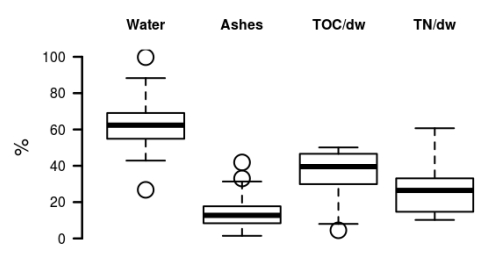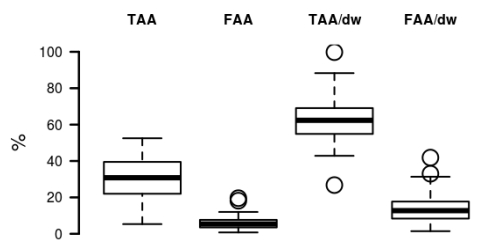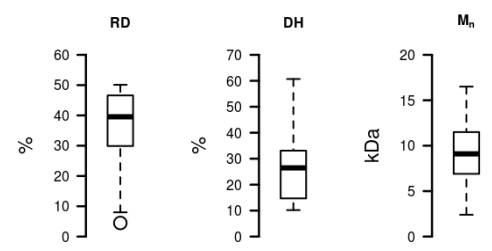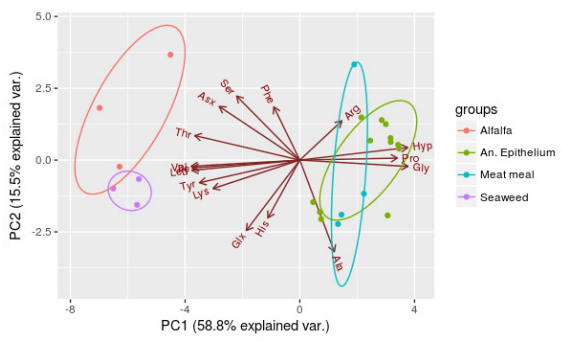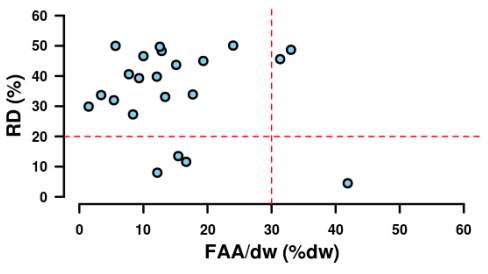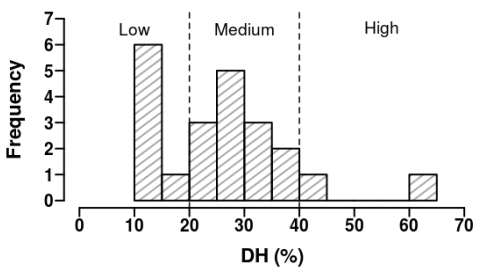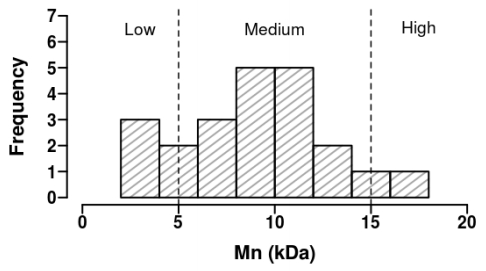1. Introduction
Protein hydrolyzates (PHs) can be obtained by thermal, chemical and/or enzymatic hydrolysis of raw materials of animal or vegetal origin. PHs are a well-known group of plant biostimulants [1] and their use in agriculture increased significantly during the last decade [2]. PHs are mainly used in order to improve the nutrition level of plants [3], stimulate their metabolism [4] and increase their resistance to abiotic stress [5]. PHs can be therefore considered products with a wide spectrum of activity.
Chemically, PHs are a mixture of free amino acids, oligopeptides and polypeptides. Due to different source materials and different hydrolytic processes used during production, PHs are a very complex and inhomogeneous category of products, a critical issue for both manufacturers and potential users of such products. Furthermore, the exact nature of the "active ingredient(s)" present in PHs is not clear, even though some amino acids (i.e. tryptophan, methionine, arginine, proline, etc.) are well known precursor of phytohormones or accumulate in cells following exposure to osmotic or oxidative stress. Some peptides can also influence plant metabolism in various ways [6]. We have therefore focused our attention on the amino acids and peptides concentration of PHs as the most useful indicators for their characterization.
Firstly, we have considered the total amino acids (TAA) concentration in PHs. TAA are generally strictly correlated to organic matter concentration, and are perhaps the only indicator of protein derived compounds in the end product. Nevertheless, the total concentration of major amino acids (i.e. proline and hydroxyproline for collagen-based products), or even better the molar ratio of all protein derived amino acids, are good indicators for the identification of the raw material used for the production of the PH. The presence or the absence of uncommon amino acids may also be used for the same purpose (i.e. the absence of tryptophan in collagen).
The concentration of free amino acids (FAA) in PHs is generally considered to be the most significant parameter. In fact, the hydrolytic processes used during PHs production are continuously implemented. These processes fall mainly in two groups: chemical (or better thermo-chemical) and enzymatic processes. However, it is clear that it is also possible to use a multi-step approach with chemical plus enzymatic hydrolysis.
Chemical hydrolysis is based on the use of concentrated solutions of strong bases (i.e. sodium hydroxide, calcium hydroxide) or acids (i.e. sulphuric acid, hydrochloric acid) under controlled temperature and pressure conditions. These processes are not selective and while they release FAA by breaking the peptide-bonds, they can also lead to degradation (i.e. tryptophan in acid hydrolysis) or transformation (i.e. arginine in citrulline) of several amino acids.
Another important factor to take into account is the racemization of the released amino acids, as after cleaving the peptide bonds the released amino acids are casually converted into the l-or d-form. However, amino acids are naturally present only in the l-form, while d-amino acids are probably less effective or even toxic to living organisms [7]. The racemization degree (RD) or the ratio between d-form and d-plus l-form is therefore another important indicator of PHs quality and identification of hydrolytic process.
Enzymatic hydrolysis, on the other hand, which is selective and can be conducted under milder conditions, does not yield d-amino acids during the cleavage of peptide bonds. However, one should always keep in mind that hydrolytic processes yield not only FAA, but also cut polypeptides into oligopeptides.
Hydrolysis of peptide bonds therefore increases the number of free amino groups (-NH2), released after the cleavage of peptide bonds. The ratio between the number of cleaved peptide bonds and the total number of peptide bonds defines the degree of hydrolysis (DH). The DH of a product is determined by calculating the ratio between free amino groups and total organic nitrogen. This indicator is very important, since it is a quantitative expression of the hydrolytic efficiency of the process. Nevertheless, the same DH value can be associated with samples containing widely different mixtures of peptides and FAA.
In order to define the size of the peptides present in a product, we must use a different approach. Considering that the PHs are a heterogeneous mixture, we can only determine the average molecular size (MS) of the peptides present in said mixture. Typically, the distribution of MS of peptides in PHs shows a unimodal distribution [4] that can be described by calculating the number-average (Mn) and weight-average molecular size (Mw). MS is an important indicator, since the major biostimulant activity seems to be linked to a specific MS fraction of peptides (i.e. peptides with low MS).
In order to characterize and describe PH biostimulants, we have therefore analyzed more than twenty PHs for (ⅰ) total amino acid concentration, (ⅱ) free amino acid concentration, (ⅲ) racemization degree, (ⅳ) degree of hydrolysis, and (ⅴ) apparent average molecular size.
2. Materials and Methods
2.1. Characterization of the protein hydrolyzate biostimulants
The protein hydrolyzates (PHs) used in this study were purchased on the market. The main source materials, declared by manufacturers, were: animal epithelium (12 samples), meat meal (4 samples), seaweed (3 samples), and alfalfa (3 samples).
Moisture and ashes were determined by weight loss at 105 and 550 ℃, respectively; reaction (pH) in water (3/50, w/v); electrical conductivity (EC) in water (1/10, w/v); total organic carbon (TOC) by wet oxidation method with potassium dichromate and total nitrogen (TN) with the Kjeldahl method.
2.2. Total and free amino acids determination
Total amino acids (TAA) were determined by chemical hydrolysis of samples in 6 M hydrochloric acid (HCl), and free amino acids (FAA) were extracted in 0.1 M HCl. TAA and FAA were determined by RP-HPLC after derivatization with 9-fluorenylmethoxycarbonyl chloride [8] using a 1525 binary HPLC (Waters) equipped with an Amino Tag TSK-Gel ODS 80-TM (Varian) 150 × 4.6 mm column.
2.3. Racemization degree
The racemization degree (RD) was determined according to the capillary electrophoresis method proposed by Cavani et al. [9]. Briefly, free l-alanine (l-Ala) and d-alanine (d-Ala) were separated and measured by capillary electrophoresis after derivatization with dansyl chloride, and was calculated using the follow equation: RD (%) = 100 · d-Ala / (l-Ala + d-Ala).
2.4. Degree of hydrolysis
The degree of hydrolysis (DH) was determined based on free α-amino N / total organic N ratio [10]. The free α-amino N was determined with the o-phthaldialdehyde plus N-acetylcysteine spectrophotometric assay [11].
2.5. Average molecular size
The apparent molecular size was determined using size exclusion high performance chromatography [12]. Number-average molecular size (Mn) was calculated using the following equation: Mn = Σ (ni
· Mi) / Σ ni; where Mi and ni are the molecular size and the height of each ith fraction eluted at the ith volume in the chromatogram, respectively [13].
2.6. Data handling and statistical analysis
Statistical analysis was carried out using the software R version 3.4.0 [14]: Pearson's product moment coefficient was determined using the command "correlation" from the package "agricolae", the Shapiro-Wilk test for normality using the command "shapiro.test" from the package "stats", the principal component analysis (PCA) using the command "prcomp" from the package "stats".
3. Results and Discussion
The major chemical characteristics of the 22 analysed PHs are summarized in Figures 1 and 2. The pH values of the tested PHs ranged from 4.1 to 8.2 (Figure 1), with an average value of 6.6 and a coefficient of variability (cv) of 17.9%, while electrical conductivity (EC) displayed a high variability and ranged from 3.9 to 27 dS m−1, with an average value of 10.2 dS m−1 (cv = 56.6%). Considering the distribution of the observed EC values and that the Shapiro-Wilk's test for the normal distribution was highly significant (P = 0.0075), the unusually high EC value (27 dS m−1) observed in sample #11, was most probably an outlier. A more realistic of EC range should therefore considered to be the one between 3.9 to 20 dS m−1.
Figure 2 shows that water contents of PHs ranged from 16.7 to 88.8% (w/w) on fresh weight basis, with an average value of 52.3% (cv = 33.5%). This is not surprising, since the tested products were both in liquid and powder form. The same figure also shows that the content of ashes was also highly variable and ranged from 0.21 to 18.9% (w/w) on fresh weight basis, with an average value of 7.4 (cv = 65.1%), that total organic carbon (TOC) ranged from 33 to 58% (w/w) on dry weight basis with an average value of 42% (cv = 13.4%) and that total nitrogen (TN) concentration ranged from 4.1 to 17.7% (w/w) on dry weight basis, with an average value of 11.8% (cv = 34.3%).
The results of the analysis of total amino acid concentration (TAA), and free amino acid concentration (FAA) in the tested PHs are summarized in Figure 3. TAA concentration ranged from 5.33 to 52.5% (w/w) on fresh weight basis, with an average of 30.1 (cv = 44.6%). The variability decreases when TAA is reported on dry matter basis. In this case it ranges from 26.8 to 99.8%, with an average value of 61.8 (cv = 24.3%). FAA concentration of the tested PHs also displayed high variability, and ranged from 0.76 to 19.6% (w/w) on fresh weight basis, with an average of 6.7% (cv = 74.3%). This high variability and the absence of the not normal distribution of data was confirmed by the Shapiro-Wilk's test (P
= 0.007) and is linked to the presence of two outliers (samples #2 and #14) with a FAA concentration near to 20%.
The RD of the tested PHs ranged from 4.5 to 50% (Figure 4), indicating that on the market it is possible to find PHs with both low and high racemization degree. The calculated average value of RD was 35.5% (cv = 38.6%). The lowest observed value (sample #2) could be considered an outlier.
The results of determination of the DH of the studied PHs samples are summarized in Figure 4. As already noticed in the case of other tested parameters, DH displayed a high level of variability of the obtained results. The lowest observed value was 10.2, while the highest observed value was 60.7%. The average DH value was 26.3% (cv = 46.7%).
The results of the determination of the Mn of the tested PHs are also summarized in Figure 4. The Mn ranged from 2.35 to 16.5 kDa with an average value of 8.91 kDa (cv = 41.0%).
The chemical characterization of the 22 tested PHs clearly indicates a substantial variability of this type of products. This is due both to the different origin of the start material (i.e. animal or vegetal) and the hydrolytic process used during the production process (i.e. chemical or enzymatic).
However, some considerations can be made based on the correlation between these parameters. The correlation matrix, which is reported in Table 1, indicates the presence of some significant correlations.
Table 1. Correlation matrix (Pearson's product moment coefficients) of studied parameters.
| Parameters |
pH |
EC |
Water |
Ashes |
TOC |
TN |
TAA |
FAA |
RD |
DH |
| pH |
1 |
|
|
|
|
|
|
|
|
|
| EC |
−0.12 |
1 |
|
|
|
|
|
|
|
|
| Water |
−0.01 |
−0.51* |
1 |
|
|
|
|
|
|
|
| Ashes |
−0.10 |
0.83*** |
−0.42 |
1 |
|
|
|
|
|
|
| TOC |
0.06 |
0.37 |
−0.94*** |
0.22 |
1 |
|
|
|
|
|
| TN |
0.11 |
0.14 |
−0.81*** |
−0.07 |
0.93*** |
1 |
|
|
|
|
| TAA |
0.07 |
0.19 |
−0.87*** |
0.07 |
0.93*** |
0.91*** |
1 |
|
|
|
| FAA |
0.18 |
−0.20 |
−0.32 |
−0.29 |
0.47* |
0.52* |
0.33 |
1 |
|
|
| RD |
−0.39 |
0.30 |
−0.22 |
0.37 |
0.11 |
0.07 |
0.04 |
−0.05 |
1 |
|
| DH |
0.30 |
−0.26 |
0.48* |
−0.16 |
−0.53* |
−0.53* |
−0.48* |
−0.01 |
0.04 |
1 |
| Mn |
0.31 |
−0.03 |
0.18 |
−0.21 |
−0.34 |
0.42* |
−0.30 |
0.42* |
−0.28 |
−0.19 |
TOC = total organic carbon, TN = total nitrogen, TAA = total amino acids, FAA = free amino acids, RD = racemization degree, DH = degree of hydrolysis, Mn = number-average molecular size.
* Correlation is significant at 0.05 level (two sided); ** correlation is significant at 0.01 level (two sided); *** correlation is significant at 0.001 level (two sided). |
Electrical conductivity showed a negative correlation with water content (r = −0.51, P < 0.05) and a strong positive correlation (r = 0.83, P < 0.001) with ashes content. It appears therefore clear that a reduction in water content and an increase in salt concentration lead to an increase of EC. However, the increase of ashes (or salts) in some of the tested PHs is probably the consequence of the type of hydrolysis used during their production. The PHs with high ashes content or high EC are therefore most likely to have been obtained through chemical hydrolysis.
Since chemical hydrolysis leads to a complete racemization of free amino acids, we expected to find a close correlation between the RD and ashes content. Conversely, we have observed only a weak correlation (r = 0.37, P = 0.09). This lack of correlation could be attributed to the fact that hydrolysis can also be obtained through mixed hydrolysis (chemical + enzymatic) and that complete racemization can also be achieved by chemical hydrolysis with different concentrations of bases or acids.
TOC showed a high correlation both with TN (r = 0.93, P < 0.01) and TAA (r = 0.93, P < 0.01), indicating that these parameters are just different indicators of the organic matter content of the products. TOC, TN and TAA also correlated with FAA and DH (Tab. 1), but it is difficult to find an explanation for this behavior.
Unexpectedly, DH was not correlated with FAA (r = −0.01,
P > 0.05). However, when FAA was expressed on dry matter basis in order to exclude the dilution effect, it was possible to observe a weak correlation (r = 0.39, P = 0.07). Finally, an even closer correlation could be observed (r = 0.68, P < 0.001) after the exclusion of two outliers. This indicates that DH is generally related to FAA concentration, even though several other possible exceptions should be taken into account. The correlation could also be attributable to the enzymatic phase of hydrolysis that allows the regulation of the release of amino acids or peptides by using specific exo-or endopeptidases.
The lack of correlation between parameters clearly indicates that it is not possible to characterize these products by using only one or even few parameters and that it is a necessary to utilize a multiparametric approach. This calls for the use of a wider array of different parameters in order to characterize the PHs present on the market.
TAA concentration, which was the first indicator we used, is an indicator of organic matter content of PHs, such as TOC and TN. More interesting is the (total) amino acid composition of PHs, since it is an indicator of the nature of the starting matrix used to produce the PHs [6]. Table 2 reports the value of Pearson's product moment coefficient between the amino acid composition of PHs and the amino acid composition of the natural compounds that are declared to be the source material used for PHs production. The results substantially confirmed that the amino acid composition of the final product mirrors the amino acid composition of the source material. For example, by applying the principal component analysis (PCA) to the amino acid composition of PHs it is possible to distinguish alfalfa and seaweed based products from each other (Figure 5). However, given the similarity between the two matrices, by using the same tools it is not possible to clearly discriminate between PHs originating from animal epithelium and those originating from meat meal. TAA composition could therefore be considered a suitable indicator for the recognition of the declared source material, even though it appears necessary to increase the knowledge about the exact amino acids composition of the matrices used for the production of PHs. In fact, we could use only data for the sixteen amino acids obtained during acid digestion, while natural matrices contain not only the 20 proteinogenic amino acids, but also others non-proteinogenic amino acids that could be also used as markers to recognize different starting matrices.
Table 2. Correlation (Pearson's product moment coefficients) between amino acids composition of investigated PHs and amino acid composition of some natural compounds.
| Samples |
Declared source |
Natural compounds |
| Collagena |
Alfalfa hayb |
Meat mealc |
Seaweedd |
| #01 |
Animal epithelium |
0.943*** |
0.138 |
0.823*** |
0.220 |
| #02 |
Animal epithelium |
0.990*** |
0.086 |
0.859*** |
0.206 |
| #03 |
Animal epithelium |
0.893*** |
0.128 |
0.878*** |
0.397 |
| #04 |
Animal epithelium |
0.991*** |
0.082 |
0.891*** |
0.277 |
| #05 |
Meat meal |
0.887*** |
0.156 |
0.892*** |
0.437* |
| #06 |
Animal epithelium |
0.991*** |
0.074 |
0.859*** |
0.214 |
| #07 |
Animal epithelium |
0.992*** |
0.076 |
0.864*** |
0.212 |
| #08 |
Meat meal |
0.859*** |
0.182 |
0.892*** |
0.437* |
| #09 |
Animal epithelium |
0.992*** |
0.034 |
0.850*** |
0.180 |
| #10 |
Meat meal |
0.974*** |
0.115 |
0.891*** |
0.277 |
| #11 |
Animal epithelium |
0.995*** |
0.052 |
0.848*** |
0.173 |
| #12 |
Animal epithelium |
0.872*** |
0.100 |
0.852*** |
0.385 |
| #13 |
Animal epithelium |
0.755** |
0.006 |
0.568* |
0.085 |
| #14 |
Animal epithelium |
0.868*** |
0.166 |
0.876*** |
0.405* |
| #15 |
Alfalfa |
0.083 |
0.940*** |
0.346 |
0.537* |
| #16 |
Seaweed |
0.074 |
0.633** |
0.517* |
0.908*** |
| #17 |
Seaweed |
0.043 |
0.514* |
0.469* |
0.889*** |
| #18 |
Seaweed |
0.086 |
0.582* |
0.548* |
0.900*** |
| #19 |
Alfalfa |
0.044 |
0.775** |
0.438* |
0.676** |
| #20 |
Animal epithelium |
0.991*** |
0.065 |
0.852*** |
0.200 |
| #21 |
Alfalfa |
0.074 |
0.893*** |
0.426* |
0.752** |
| #22 |
Meat meal |
0.985*** |
0.076 |
0.883*** |
0.269 |
a Bovine collagen [6]; b Alfalfa hay [6]; c Beef meat meal [15]; d Laminaria sp. seaweed [16].
* Correlation is significant at 0.05 level (two sided); ** correlation is significant at 0.01 level (two sided); *** correlation is significant at 0.001 level (two sided). |
As well as for free amino acid concentration, PHs once again displayed a wide variability regardless the source material. This results confirm that the type of hydrolytic process plays a greater role than the source material in the final FAA concentration. Since the biological activity of D-amino acids is largely unknown [7], the RD of FAA is another important issue that should be taken into account. In fact, as it can be seen in Figure 6, most PHs are in the upper left-hand quadrant, where FAA < 30% and RD > 20%, meaning that the most of the samples have only a limited FAA concentration and a high RD. This indicates a prevalence of chemical hydrolysis during production, since it is during this process that RD reaches its maximum value (i.e. RD = 50%). Only one sample is present in the lower right-hand quadrant, where FAA > 30% and RD < 20%, indicating that it is not so easy to obtain PHs with high FAA concentration and a low RD. This is probably due to enzymatic hydrolysis being complex to manage and expensive. The few samples present in the other quadrants, two in the upper right corner and three in the lower left corner, show that it is possible to manage the hydrolytic process in order to obtain PHs with different characteristics.
The histogram reported in Figure 7 shows that the observed degree of hydrolysis follows a pseudo-bimodal distribution, with a sharp peak at low DH (11–15%), and a wide pseudo-Gaussian peak ranging from 15 to 45%. Only one sample was out of this distribution (DH = 60–65%). These results indicate that the PHs present on the market are most probably obtained with two principal hydrolytic processes. The first is possibly a mild process that generates PHs with low DH. However, since DH is only a measure of the intensity of the hydrolytic process (number of peptide bonds cleaved) and not of the quality of the process, it is not possible to link DH with any particular kind of hydrolysis. The second one produces PHs with a wide DH range and an average value near to 30%. Considering this distribution of DH data (Figure 7), we can categorize PHs in three classes with low (<20%), medium (20–40%), and high (>40%) DH.
Since PHs are heterogeneous mixture of peptides and amino acids, we could perhaps consider the polydispersity of the molecular sizes around an average value, such as the number-average molecular size (Mn). The histogram of this indicator presents a distribution similar to that observed for DH (Figure 8), with a sharp peak a low Mn (<5 kDa), and a wide band with Mn between 5 and 15 kDa. As discussed above, this indicator does not correlate with DH due to the fact that a high DH cannot reduce the Mn, because the Mn does not take into consideration the FAA. On the basis of results show in Figure 8 we can again categorize the PHs in three classes with low (<5 kDa), medium (5–15 kDa), and high (>15 kDa) Mn. Considering that peptides with low molecular size can play a role as auxin-like and/or gibberellin-like compounds and signaling molecules [4,17], it is noteworthy that 5 of the 22 PHs have a Mn lower than 5 kDa.
Finally, even though each and every one of these indicators demonstrated to be important to characterize PHs, none of them, individually, was sufficient to describe this category of products. Not even by using more complex statistical techniques, such as the PCA (data not shown), it was not possible to discriminate among source materials and/or hydrolytic processes, probably because the number of different samples was not high enough for possible differences to stand out.
4. Conclusions
The chemical characterization of PHs demonstrated the heterogeneity of this class of products present on the market. The used indicators were able to discriminate between some aspects of PHs: (1) total amino acid composition was useful in order to recognize the source materials; (2) free amino acid concentration and racemization degree underlined the kind and the quality of the hydrolytic processes; (3) the degree of hydrolysis pointed out the intensity of the hydrolytic process; (4) the number-average of molecular size described the average size of the peptides and their polydispersity.
In conclusion, when we talk about PHs, we talk about a very inhomogeneous class of products, which can be adequately characterized only through a multi-analytical approach.
Conflict of interest
All authors declare no conflicts of interest in this paper.










 DownLoad:
DownLoad: 